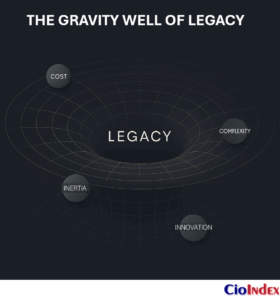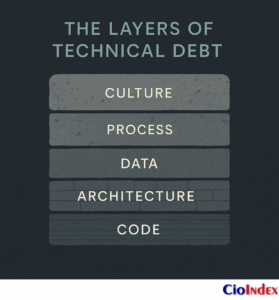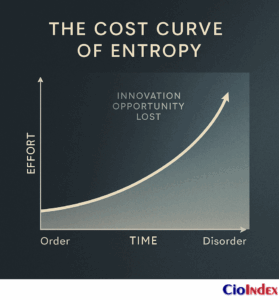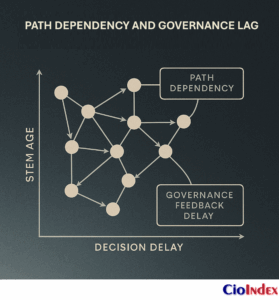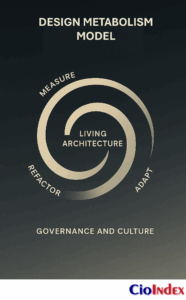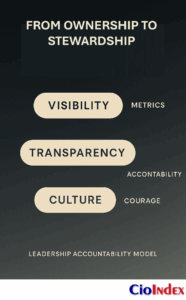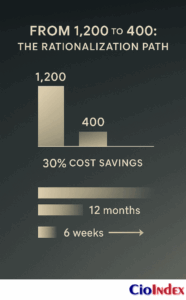The Hidden Gravity of Legacy
Every organization lives with an inheritance. Some inherit strong systems and disciplined architectures; others inherit silos, workarounds, and forgotten integrations that once powered growth but now resist change. What begins as a foundation eventually becomes a force — silent, invisible, and persistent. Legacy technology does not merely exist within an enterprise; it defines its motion.
The metaphor of gravity is fitting. It cannot be seen, but it governs everything that moves. Digital transformation efforts often fail not because leaders lack vision, but because they underestimate the gravitational pull of the past — the weight of architectures that were never designed to evolve. Modern front ends glide across brittle cores; new customer journeys rely on code written decades ago. Enterprises believe they are accelerating toward the future, but much of their energy is consumed simply resisting their own inertia.
Legacy IT is not synonymous with “old.” Age is a symptom, not the cause. The real issue is architecture without adaptability — systems that cannot flex, scale, or integrate at the velocity modern strategy demands. Even the most modern platforms begin aging the moment adaptability ends. What distinguishes legacy from living systems is not when they were built, but whether they can continue to change.
This distinction exposes a deeper psychological trap — functional myopia. Because legacy systems work, they appear harmless. Their reliability masks their rigidity. The business continues to run, reports continue to generate, customers continue to transact — and so replacement is deferred. Over time, a culture of accommodation forms around them: new initiatives are shaped to fit old capabilities rather than the other way around. What began as technical convenience becomes strategic constraint.
Each investment in legacy deepens its orbit. The more an organization spends maintaining the old, the more gravity it gains. Budgets once meant to propel innovation instead reinforce past structures. The economics of the past begin to dictate the logic of the future — a condition of capital inertia where renewal competes against its own sunk costs. The longer the orbit, the greater the energy required to break free.
Transformation initiatives that operate above this layer — new applications, data lakes, or customer experiences — often mistake motion for progress. They innovate at the surface while the underlying infrastructure remains anchored in an earlier logic. The result is surface agility, structural paralysis. The organization appears to move quickly, but its foundations barely shift.
Legacy IT’s true danger lies in its invisibility. It resists not through confrontation, but through compliance — it continues to function, to process, to output. And that illusion of stability breeds complacency. Yet beneath it, the system is hardening. Interfaces multiply, integrations tighten, and each workaround becomes another gravitational line binding the enterprise to its past.
Digital transformation, then, begins with an act of recognition: the past does not fade — it compacts. Every decision not to modernize becomes sediment in the organizational core. The challenge is not to escape gravity, but to understand its orbit — to redesign systems that can move freely without breaking the continuity of what came before.
Transformation often stalls not because of vision, but because the past refuses to decompose.
To understand why this gravity persists, we must look deeper — not into the past itself, but into the debts it created.
Understanding Technical Debt: Beyond Code
Every shortcut in technology carries a price — each unmade correction becomes an interest payment on the organization’s own speed. Some debts are taken consciously to accelerate delivery or capture opportunity; others accumulate quietly through neglect or haste. Over time, these fragments of unfinished design harden into architecture.
The term technical debt was introduced by Ward Cunningham in the early 1990s to describe the tension between short-term delivery and long-term maintainability. Like financial borrowing, debt can accelerate progress when managed — but compounds disastrously when forgotten. It is the institutionalization of haste: the decision to trade future flexibility for present advantage.
Most definitions of technical debt remain confined to the software layer — messy code, skipped testing, hard-coded rules. The concept, however, extends far beyond code; it permeates architecture, governance, and culture. In a mature enterprise, technical debt becomes an organizational condition — a systemic residue that forms wherever speed outruns design and delivery outpaces reflection. It is the architectural record of every moment an organization chose momentum over mastery.
Five primary forms of debt define this condition:
- Code Debt — Unrefactored, brittle, or obsolete code that inflates maintenance effort and error risk.
- Architecture Debt — Designs too rigid to modularize or integrate, creating dependencies that slow innovation.
- Data Debt — Inconsistent or siloed data models that erode trust and hinder analytics.
- Process Debt — Workflows sustained by automation rather than renewal.
- Cultural Debt — A tolerance for workarounds that normalizes deviation as competence.
These layers form a stratigraphy of constraint — decisions that once made sense now interlock to prevent change. Code debt hardens into architecture debt; architecture debt perpetuates process debt; process debt cultivates cultural debt. The result is not disorder but ossification — a system too stable to evolve.
The lifecycle of debt is predictable. It begins as a shortcut, manageable if repaid, compounding if ignored. Each workaround spawns others, integrations multiply, and the cost of change rises exponentially. This is how small inefficiencies harden into architecture. Each deferred refactoring or postponed renewal adds another layer to the sediment of inertia.
The most insidious form is shiny legacy — systems that look modern but remain architecturally unchanged. Cloud migrations without rationalization, re-platforming for optics, or digital front ends masking static cores all create this illusion: innovation at the surface, inertia underneath.
Understanding technical debt is therefore not a matter of accounting but of systems awareness — seeing the hidden architecture of dependency that links yesterday’s compromises to tomorrow’s constraints. Every decision leaves a half-life — a residual structure that shapes what follows. The organizations that master transformation are not those that avoid debt, but those that manage its lifecycle with intent: knowing when to borrow, when to repay, and when to rebuild.
Technical debt is not the residue of the past; it is the architecture of the present shaped by unexamined trade-offs.
The Economics of Entropy
Every system tends toward disorder unless energy is continuously invested to sustain it. Technology is no exception. What begins as elegant design drifts toward complexity as patches and integrations accumulate. This is the economics of entropy — the slow inflation of effort required simply to keep things working.
In most enterprises, this entropy is misclassified as “maintenance.” Yet it is far more than the operational cost of running software. It is the hidden tax on innovation — the opportunity cost of complexity. Each layer of legacy consumes time, talent, and capital that could otherwise fuel transformation. When 70 to 90 percent of IT budgets sustain existing systems, the enterprise is not investing in the future — it is paying rent to its past.
Budgets designed for growth gradually become mechanisms of preservation — a distorted financial gravity that pulls resources backward. Over time, the organization’s maintenance-to-innovation ratio becomes a measure of strategic vitality. When the ratio tilts too far toward maintenance, the enterprise begins sustaining itself instead of evolving.
Technical debt compounds like financial interest. Each workaround offers short-term relief but multiplies long-term cost. Minor inefficiencies — duplicated data, brittle workflows, outdated integrations — accumulate into systemic drag, inflating the cost of every new initiative.
What appears as stable operating expense conceals a liquidity problem: capital locked in maintenance cannot be redeployed quickly. Innovation becomes less a question of funding than of structural liquidity — the ability to reallocate energy from preservation to creation without destabilizing operations.
When the past monopolizes resources, even well-designed transformation programs underperform. Projects that should yield step-change benefits struggle to overcome friction. Organizations spend more on technology than ever, yet their return on adaptability continues to decline.
Technical debt erodes value like inflation — quietly raising the price of every improvement. Over time, the enterprise normalizes these inflated costs as the price of doing business. The more it adapts around inefficiency, the more inefficiency hardens into structure. Entropy becomes policy.
The true measure of digital maturity is not how much an organization spends on technology, but how much of that spend creates new capacity instead of preserving the old. Renewal is not a project — it is a fiscal discipline. Transforming technology without transforming the economics that govern it only compounds the debt.
When maintenance becomes the business model, innovation becomes an exception.
Architectural Inertia: When Systems Outlive Strategy
Every architecture reflects a moment in time — a set of assumptions about markets, customers, risks, and capabilities. When those assumptions change, architecture should evolve with them. Yet in most organizations, it does not. Systems endure long after the logic that justified them has expired. They continue to perform familiar tasks efficiently while making new ones nearly impossible. This is architectural inertia — the silent persistence of structures that have outlived their strategic purpose.
Inertia rarely announces itself as failure. It appears as stability. Systems that “just work” become sacred — too critical to touch and too complex to replace. Over years, these constraints become self-reinforcing: new projects depend on old systems, budgets prioritize their upkeep, and teams organize themselves around their limitations. Over time, the system stops serving the business and the business begins serving the system.
The problem is not technology itself, but path dependency — the way each past choice narrows the next. Every integration, interface, and contract adds another thread of dependency. Over decades, these threads compact into an unyielding core — an institutional geology of logic and habit. Each layer made sense once, but together they anchor the enterprise in an outdated worldview.
This inertia is amplified by the governance feedback delay — when oversight mechanisms operate on fiscal calendars rather than system lifecycles. Decisions that shape architecture, from procurement to compliance, move on multi-year cycles while technology evolves in months. By the time governance responds, architecture has already drifted from intent. Committees evaluate projects through financial lenses designed for capital assets, not living systems. The result is a mismatch between decision speed and system velocity — strategy moves in quarters, architecture in decades.
Examples abound. Banks still process transactions on COBOL mainframes built in the 1980s because those systems, though outdated, remain reliable. Health networks continue to operate electronic record systems that predate interoperability standards. Government agencies depend on platforms so deeply entwined with regulation that replacing them would require rewriting policy itself. In each case, legacy is not neglected; it is protected — its reliability mistaken for relevance.
What makes architectural inertia so dangerous is its rationality. The systems function as intended; the dashboards glow green. There is no visible crisis to justify replacement. Yet adaptability erodes silently. As integrations multiply, the cost of change compounds, and the enterprise becomes structurally resistant to its own ambitions.
Architecture, at its best, is the physical expression of strategy — the translation of intent into structure. When it fails to evolve, it becomes the physical expression of history. The organization continues to operate within an architecture of the past, optimizing yesterday’s decisions with tomorrow’s budget.
Breaking this cycle requires a shift in mindset: treating architecture not as an artifact to be maintained, but as a living system to be renewed. Renewal begins with visibility — seeing where dependencies accumulate and distinguishing what is truly core from what is merely habitual. It continues with governance alignment — ensuring investment decisions follow the cadence of change rather than the pace of comfort.
Architecture is strategy, slowed by time. The longer it remains unexamined, the more it begins to define the enterprise itself.
The Transformation Paradox
Every organization enters digital transformation believing it is escaping the past. Many emerge more entangled than before. The paradox is that transformation, when executed without architectural discipline, often accelerates the very inertia it aims to dissolve. What appears to be progress — new platforms, automation, cloud migration — can, in reality, be the industrialization of technical debt.
The symptoms are deceptively positive: new applications, faster releases, and wider tool adoption. But beneath this movement lies accumulation. Sprints add dependencies; integrations add fragility. The pace of delivery increases while the capacity for redesign diminishes. The enterprise becomes more digital but less adaptable — a modern façade built on ancient scaffolding.
At the root of this paradox is a structural misunderstanding: transformation is not substitution. Replacing technology without rethinking its logic changes the tools but preserves the assumptions beneath them. Cloud migrations executed without refactoring simply move complexity from one environment to another. Automating outdated processes locks inefficiency in place. Digitalization without architectural renewal merely transfers yesterday’s constraints onto tomorrow’s infrastructure.
This is what might be called transformation debt — the new form of technical debt generated by transformation itself. It arises when modernization projects prioritize visible outcomes over systemic coherence — when governance measures delivery speed but not architectural integrity. The organization may modernize its surface, but beneath it, integration layers multiply, data models diverge, and operational entropy deepens.
Transformation debt has a particular danger: it feels like success. Dashboards glow green, adoption metrics rise, and teams celebrate delivery milestones. Yet each new capability depends on a network of legacy connections that grows more brittle with every iteration. The enterprise believes it is transforming, when in fact it is redecorating the past.
The paradox extends beyond technology into governance. Many transformation programs are structured around project-based funding and siloed accountability. Each initiative optimizes for its own outcomes rather than shared architectural goals. Without a unifying design language or enterprise architecture function, transformation becomes a collection of parallel accelerations — each moving fast independently but diverging collectively. The result is speed without synthesis.
This pattern is familiar to every CIO. The more success an organization claims, the harder integration becomes. The more automation it adds, the more exceptions it invites. The more agile it becomes, the more coordination it requires. Momentum turns into mass — and mass, once again, becomes gravity.
Breaking the paradox requires reframing transformation as a structural discipline, not a sequence of projects. The objective is not modernization but coherence — systems designed to evolve together rather than apart. Success must be measured not by what is delivered, but by what is simplified, unified, or retired. Every transformation must reduce future friction, not multiply it.
The real measure of transformation is not how much new technology is added, but how much unnecessary complexity is removed.
Breaking the Cycle: From Debt to Design
Escaping the legacy trap is not an act of replacement but of renewal. The objective is not to erase the past, but to re-architect it — transforming inherited systems into adaptable structures that evolve with strategy. Modernization is not a milestone; it is a discipline of continuous design.
Most organizations still treat renewal as an event. Programs launch, budgets are approved, milestones celebrated — and then the cycle resets. The logic remains unchanged: transformation as project, not practice. The result is periodic bursts of progress separated by long plateaus of entropy. The enterprise moves in phases of disruption rather than rhythms of evolution.
To break this pattern, architecture must function as a living system, continuously shaping and reshaping the enterprise’s technical landscape. Design cannot be a static blueprint; it must be a responsive system of principles, feedback, and iteration. Every line of code, every integration, every vendor relationship should trace back to a coherent architectural intent — one that favors flexibility over permanence and coherence over expedience.
At the heart of this shift lies a new understanding of value. Innovation is not measured by how much is built, but by how much redundancy and complexity are removed. Technical debt must be treated as an enterprise liability, visible on the balance sheet of strategic capacity. The goal is not to deliver faster, but to design systems that reduce the cost of change itself. When adaptability becomes measurable, renewal becomes habitual.
Several disciplines sustain this shift:
- Continuous Refactoring — Small, regular improvements that prevent large, disruptive overhauls.
- Debt Registers — Transparent inventories of technical liabilities, prioritized by business impact.
- Architectural Health Metrics — Quantitative indicators such as modularity, integration velocity, and defect-to-value ratio that assess adaptability.
- Investment Governance — Decision frameworks that treat refactoring and simplification as strategic reinvestments, not operating expenses.
- Platform and Composability Thinking — Designing modular ecosystems where components evolve independently yet remain coherent.
- Cultural Renewal — Rewarding simplification and stewardship alongside innovation and speed.
These disciplines form a design metabolism — a self-regulating system in which architecture renews itself as strategy evolves. When integrated with governance, this metabolism enables organizations to pay down technical debt continuously without halting progress. It replaces the stop-start logic of modernization with a steady flow of intentional adaptation.
The mindset shift is subtle but profound. The question is no longer How modern is our technology stack? but How adaptable is our system of systems? Transformation is managed not through programs, but through the health of the architecture itself. Renewal is no longer a disruption to stability — it is the mechanism that preserves it.
Sustainability in digital transformation is not achieved through permanence, but through perpetual design.
The Leadership Imperative: Owning the Debt
Technical debt may begin in code, but it matures in governance. Its persistence is not a failure of engineering discipline; it is a failure of leadership accountability. Funding priorities and risk tolerances determine whether debt compounds or is contained. For this reason, legacy renewal cannot rest with IT alone; it must be owned where strategy, investment, and culture converge — at the level of leadership.
Leaders often inherit systems without inheriting their reasoning. They see portfolios of assets — applications, contracts, vendors — but not the decision logic that connects them. As a result, modernization debates are framed in technical or financial language rather than in governance terms — who decides, who funds, and who owns the consequences of delay. Without explicit accountability, debt becomes ambient: everyone’s problem, and therefore no one’s.
CIOs sit at the center of this paradox. They are expected to deliver innovation while managing accumulated complexity — to accelerate transformation while maintaining stability, to reduce cost while expanding capability. The equation is impossible unless the circle of ownership expands. The board must treat technical debt as enterprise resilience, not IT hygiene. Finance must recognize modernization as asset renewal, not expense. Risk and compliance must see every outdated system as latent exposure — a threat to security, continuity, and reputation alike.
Ownership begins with visibility. Leadership needs clear, intelligible metrics that translate technical health into strategic language — the same way financial statements translate operations into value. Dashboards should report not only uptime and incidents but also architectural indicators: debt ratios, modularity scores, dependency maps, renewal velocity. What cannot be seen cannot be governed.
Visibility must evolve into transparency. Technical debt should be discussed with the same candor as financial debt — tracked, reported, and prioritized. This transparency redefines modernization as fiduciary duty rather than discretionary initiative. Once leaders understand that technical debt carries measurable risk, the question shifts from Can we afford to modernize? to Can we afford not to?
Equally critical is the cultural dimension of ownership. Legacy persists because organizations lack the psychological safety to retire it. Ending something that still works feels dangerous — operationally and politically. True modernization demands courage: the courage to replace success that no longer scales, to decommission what once defined excellence. Renewal depends as much on what leadership is willing to stop doing as on what it chooses to start.
Owning the debt is not about control, but stewardship — creating the conditions for systems to evolve responsibly. It means aligning governance with the pace of change, funding with adaptability, and culture with learning. When stewardship becomes embedded in decision-making, debt ceases to be a liability and becomes a signal — evidence of where structure must evolve faster than intent.
Leadership in digital transformation is not about commanding change, but sustaining coherence — ensuring that what evolves remains aligned with why it exists.
Case Insight: The Legacy Reckoning
For nearly two decades, one of the world’s largest banks had treated modernization as a cost center rather than a capability. Its core systems — some dating back to the late 1980s — were reliable but immovable. Each business unit layered its own applications on top, creating more than 1,200 systems across 40 countries. What began as diversification slowly hardened into fragmentation. Maintenance costs rose, integration slowed, and innovation timelines stretched from months to years.
The reckoning began not with a crisis, but with an audit. The board demanded visibility into the true cost of technology ownership. What emerged was not a financial report but an architectural revelation: 70 percent of IT spending was locked in “keep the lights on” activity, while only 12 percent reached initiatives that generated new capability. The issue was not underinvestment, but inverted investment — resources trapped in the past.
The new CIO reframed modernization as a business transformation, not a technical cleanup. A three-year legacy rationalization program was launched, not to replace everything, but to redesign the ecosystem for coherence. A joint CIO–CFO steering committee and enterprise architecture board reviewed every major system against three criteria: business value, technical fit, and strategic relevance. Systems meeting none were retired or absorbed; those meeting one were refactored or migrated to shared platforms; those meeting all became strategic anchors.
By year two, the application portfolio had been reduced from 1,200 to just over 400. Integration layers were simplified, operating costs fell by 30 percent, and time-to-market for new services dropped from 12 months to 6 weeks. But the most important shift was cultural. Business leaders began treating technical debt not as an IT inconvenience but as an enterprise exposure — one with real opportunity cost. Governance councils began reviewing debt registers alongside financial ledgers, making modernization a recurring item on the board agenda rather than a periodic initiative.
This transformation succeeded not through technology choices, but through alignment: financial transparency that revealed where value was trapped, architectural discipline that prioritized what mattered, and executive sponsorship that sustained commitment through discomfort. The result was not architectural perfection, but architectural integrity — a system of systems capable of evolving without collapsing under its own history.
Modernization succeeds not when technology is replaced, but when accountability is redistributed — from the server room to the boardroom.
The Freedom to Evolve
Every enterprise carries the imprint of its own history. Systems, architectures, and decisions accumulate like patterns in stone — once fluid, now fixed. The challenge of digital transformation is not to escape the past, but to reinterpret it without breaking continuity. The real measure of progress is not how much of the old is replaced, but how gracefully the organization learns to evolve beyond it.
Maturity begins when leadership recognizes that legacy is not a flaw to be eradicated, but a condition to be managed. Every modern system is only temporarily new; every innovation carries within it the seeds of its own obsolescence. The goal is not to prevent this cycle, but to master its rhythm — to design enterprises that can renew themselves as naturally as they operate.
This is the quiet truth beneath transformation: permanence is an illusion. Enduring systems do not survive by remaining stable, but by learning to change without losing themselves. The organizations that endure are those that accept impermanence as design principle — that treat every structure as temporary, every success as provisional, and every iteration as preparation for the next.
Transformation, then, is not a destination but a discipline — the capacity to evolve consciously. It is the moment when structure and intent align not around control, but around learning. When that happens, legacy ceases to be a barrier and becomes a foundation — a platform for reinvention rather than resistance.
The mark of a truly digital enterprise is not its technology, but its freedom to evolve — coherently, and without fear of its own past.
